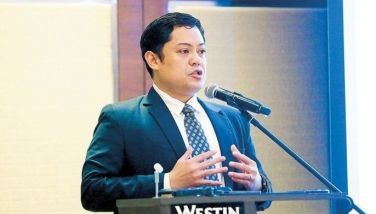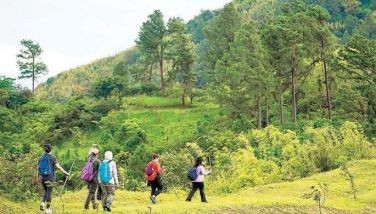Deficit problem forces ODA restructuring
May 28, 2003 | 12:00am
The government’s ballooning budget deficit is forcing the Arroyo administration to restructure its official development assistance (ODA) portfolio.
A top official of the Development Budget Coordinating Committee (DBCC) disclosed yesterday that the government’s ODA portfolio is currently undergoing a comprehensive restructuring and no new loans are being processed for application with foreign funding agencies.
According to the official, the DBCC wanted to ensure that it would not be caught unprepared by constructive cash items in the national budget which had been identified as the culprit behind the unpredictability of public expenditures.
The source said the National Economic and Development Authority (NEDA) is wrapping up its annual ODA review and this would be the basis for the policy decision of the DBCC.
A number of development projects have not received funding under the 2003 budget while others would get only minimal funding as the government tried to reduce spending to help prevent its deficit from careening out of control.
The official said there would be a significant shift in the DBCC’s ODA policy, congruent with the administrative steps that would be taken to rein in constructive cash items in the budget.
Constructive cash represent the amount that government draws down from foreign loans or aids in the form of equipment, materials and supply. The foreign donor pays the supplier directly so that the foreign assistance is delivered in kind to the respective agency.
In 2002, the DBCC said constructive cash items are programmed to reach only P12 billion but the actual full-year figure was twice this at P24 billion.
"We could not figure out when the items came in and when they were recorded. They end up being lumped together and suddenly we have overshot our target by 100 percent," Budget Secretary Emilia Boncodin said.
Although multilateral and bilateral ODA sources have been willing to provide assistance, projects fail to fall through due to the perennially low absorptive capacity of the implementing agencies and the inability of the government to provide counterpart financing often required by the donors.
According to a World Bank source, budget cuts of this nature are precisely what donors have feared. Instead of working to resolve the problems that have delayed the implementation of critical projects, the government’s reaction have been to cut the funding altogether.
At present, the NEDA said there are over 202 active ODA loans with a net commitment of $13.2 billion involving 195 project- and seven program-type of loans.
Project loans accounted for 91 percent or $12 billion while program loans accounted for nine percent or $1.2 billion. In terms of sectoral distribution, the bulk of ODA was channeled to Infrastructure Development, which received 127 loans with an aggregate amount of $9.1 billion or 69 percent of t total ODA loans portfolio.
The second biggest recipient of ODA was Agriculture, Natural Resources and Agrarian Reform, which accounted for 15 percent of total ODA (or US$2.0 billion involving 37 loans).
NEDA said Industry and Services Sector has a nine percent share, accounting for $1.2 billion, while Human Development has five percent (or $689 million with 20 loans) of total ODA.
According to NEDA, the bulk of these ODA came from the Japan Bank for International Cooperation (JBIC) which remained the country’s largest source of ODA loans.
A top official of the Development Budget Coordinating Committee (DBCC) disclosed yesterday that the government’s ODA portfolio is currently undergoing a comprehensive restructuring and no new loans are being processed for application with foreign funding agencies.
According to the official, the DBCC wanted to ensure that it would not be caught unprepared by constructive cash items in the national budget which had been identified as the culprit behind the unpredictability of public expenditures.
The source said the National Economic and Development Authority (NEDA) is wrapping up its annual ODA review and this would be the basis for the policy decision of the DBCC.
A number of development projects have not received funding under the 2003 budget while others would get only minimal funding as the government tried to reduce spending to help prevent its deficit from careening out of control.
The official said there would be a significant shift in the DBCC’s ODA policy, congruent with the administrative steps that would be taken to rein in constructive cash items in the budget.
Constructive cash represent the amount that government draws down from foreign loans or aids in the form of equipment, materials and supply. The foreign donor pays the supplier directly so that the foreign assistance is delivered in kind to the respective agency.
In 2002, the DBCC said constructive cash items are programmed to reach only P12 billion but the actual full-year figure was twice this at P24 billion.
"We could not figure out when the items came in and when they were recorded. They end up being lumped together and suddenly we have overshot our target by 100 percent," Budget Secretary Emilia Boncodin said.
Although multilateral and bilateral ODA sources have been willing to provide assistance, projects fail to fall through due to the perennially low absorptive capacity of the implementing agencies and the inability of the government to provide counterpart financing often required by the donors.
According to a World Bank source, budget cuts of this nature are precisely what donors have feared. Instead of working to resolve the problems that have delayed the implementation of critical projects, the government’s reaction have been to cut the funding altogether.
At present, the NEDA said there are over 202 active ODA loans with a net commitment of $13.2 billion involving 195 project- and seven program-type of loans.
Project loans accounted for 91 percent or $12 billion while program loans accounted for nine percent or $1.2 billion. In terms of sectoral distribution, the bulk of ODA was channeled to Infrastructure Development, which received 127 loans with an aggregate amount of $9.1 billion or 69 percent of t total ODA loans portfolio.
The second biggest recipient of ODA was Agriculture, Natural Resources and Agrarian Reform, which accounted for 15 percent of total ODA (or US$2.0 billion involving 37 loans).
NEDA said Industry and Services Sector has a nine percent share, accounting for $1.2 billion, while Human Development has five percent (or $689 million with 20 loans) of total ODA.
According to NEDA, the bulk of these ODA came from the Japan Bank for International Cooperation (JBIC) which remained the country’s largest source of ODA loans.
BrandSpace Articles
<
>
- Latest
- Trending
Trending
Latest
Trending
Latest
Recommended





























